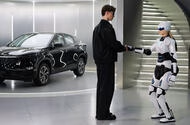The world of humanoid robots is experiencing a renaissance, and it’s not just science fiction anymore. Seven years after Honda bid farewell to its iconic Asimo, car manufacturers are diving headfirst into the robotics arena, ignited by advancements in technology and a burgeoning market for these human-like machines. Companies like BYD, Tesla, and Chery are now betting big on the potential of humanoid robots, envisioning a future where these machines could outpace car sales.
Why Are Car Companies Investing in Humanoid Robots?
The shift towards humanoid robots is driven by a combination of technological progress and market potential. The rapid advancements in robotics, artificial intelligence, and sensor technology have made it feasible for car manufacturers to explore this new frontier. Analysts are optimistic, with projections suggesting that the market for humanoid robots could surpass the global auto industry, potentially reaching a staggering $50 trillion by 2050. This figure is not just a wild guess; it’s backed by credible research and insights from financial experts.
China and the U.S. are at the forefront of this robotic revolution. Events like CES in Las Vegas and the Shanghai Motor Show have showcased the capabilities of these robots, with Chery’s Mornine making waves as a humanoid robot that can interact with customers in a dealership setting. Dressed in stylish shades and sporting long blonde hair, Mornine is designed to assist showroom staff by answering questions about vehicle specifications, marking a significant step towards integrating robots into everyday business operations.
How Are These Robots Being Used?
Chery plans to roll out Mornine as an “intelligent sales consultant” in dealerships worldwide, starting with trials in Malaysia. The idea is to enhance customer service while alleviating some of the workload from human employees. This approach reflects a broader trend where humanoid robots are envisioned not just as standalone products but as integral parts of business operations. Chery’s president, Zhang Guibing, emphasized the potential market for these robots, suggesting that they could serve dual roles in both personal and professional settings.
While the initial costs for these robots are high—estimates suggest a price tag between $35,000 to $60,000—the expectation is that prices will decrease significantly in the coming years. Tesla aims to offer its Optimus robot for between $20,000 and $30,000 by 2026, while other companies are already introducing more affordable options. For instance, BYD recently announced a humanoid robot butler priced at around $10,000, showcasing the potential for more accessible robotic solutions.
What Challenges Do Humanoid Robots Face?
Despite the excitement, the path to widespread adoption of humanoid robots is fraught with challenges. Many companies are still grappling with the complexities of developing robots that can perform a range of tasks beyond basic movements. Xpeng’s CEO, He Xiaopeng, pointed out that while progress is being made, the technology is still in its infancy, akin to where electric vehicles were 15 years ago. The promise of humanoid robots is tantalizing, but translating that promise into practical, useful products remains a significant hurdle.
Moreover, the supply chain for these robots is heavily reliant on components produced in China, raising concerns about geopolitical tensions and trade restrictions. Companies like Tesla are navigating these challenges as they seek to establish a more resilient supply chain for their robotics ventures.
What Does the Future Hold for Humanoid Robots?
The future of humanoid robots in the automotive industry is both exciting and uncertain. As manufacturers continue to innovate, the potential applications for these robots are vast—ranging from customer service roles in dealerships to assisting in manufacturing processes. The key will be convincing businesses and consumers of the value these robots can bring to their lives.
In the end, the success of humanoid robots hinges on their ability to integrate seamlessly into daily routines and business operations. As technology advances and costs decrease, we may soon find ourselves in a world where humanoid robots are as commonplace as smartphones. The big takeaway? The rise of humanoid robots isn’t just about creating machines that look human; it’s about enhancing our lives and work in ways we’re only beginning to imagine. Start thinking about how these innovations might fit into your world, and you might just be surprised by the possibilities.

